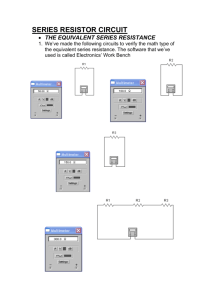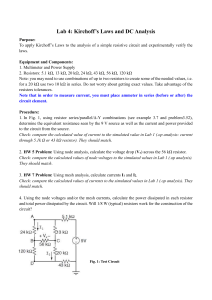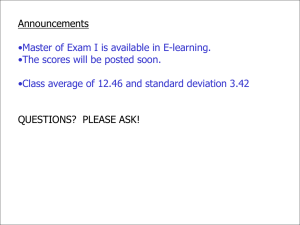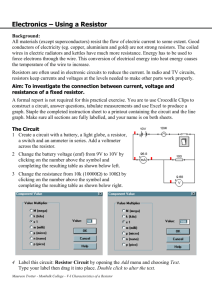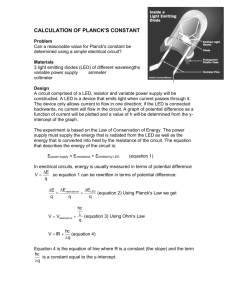Simple Series circuits
advertisement
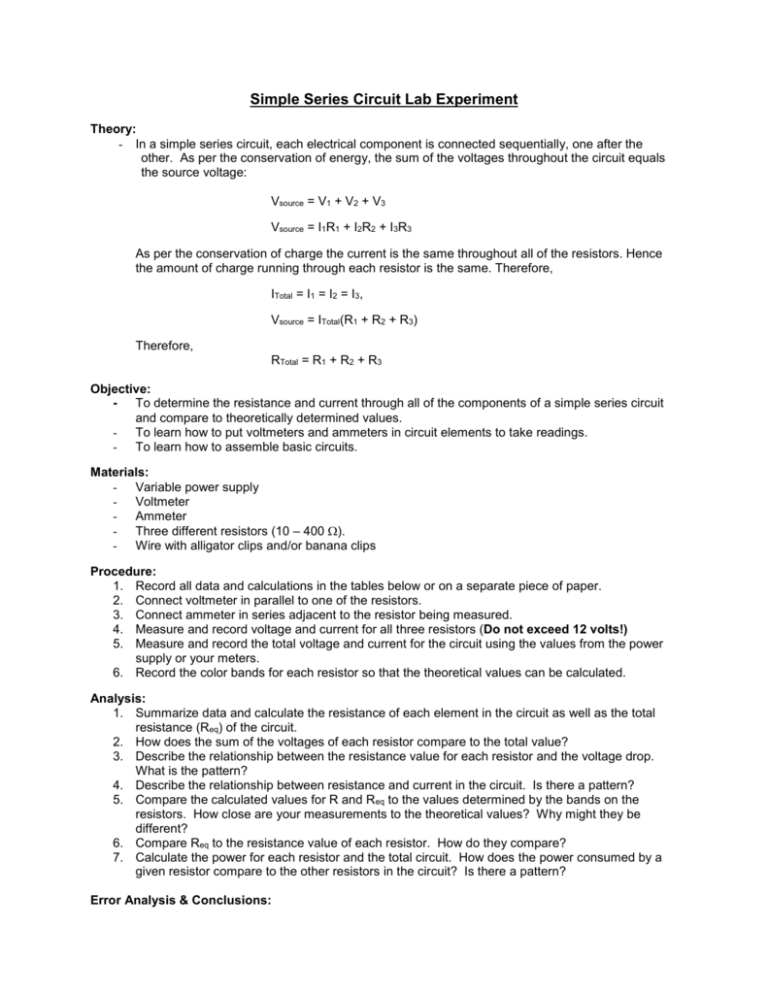
Simple Series Circuit Lab Experiment
Theory:
- In a simple series circuit, each electrical component is connected sequentially, one after the
other. As per the conservation of energy, the sum of the voltages throughout the circuit equals
the source voltage:
Vsource = V1 + V2 + V3
Vsource = I1R1 + I2R2 + I3R3
As per the conservation of charge the current is the same throughout all of the resistors. Hence
the amount of charge running through each resistor is the same. Therefore,
ITotal = I1 = I2 = I3,
Vsource = ITotal(R1 + R2 + R3)
Therefore,
RTotal = R1 + R2 + R3
Objective:
- To determine the resistance and current through all of the components of a simple series circuit
and compare to theoretically determined values.
- To learn how to put voltmeters and ammeters in circuit elements to take readings.
- To learn how to assemble basic circuits.
Materials:
- Variable power supply
- Voltmeter
- Ammeter
- Three different resistors (10 – 400 ).
- Wire with alligator clips and/or banana clips
Procedure:
1. Record all data and calculations in the tables below or on a separate piece of paper.
2. Connect voltmeter in parallel to one of the resistors.
3. Connect ammeter in series adjacent to the resistor being measured.
4. Measure and record voltage and current for all three resistors (Do not exceed 12 volts!)
5. Measure and record the total voltage and current for the circuit using the values from the power
supply or your meters.
6. Record the color bands for each resistor so that the theoretical values can be calculated.
Analysis:
1. Summarize data and calculate the resistance of each element in the circuit as well as the total
resistance (Req) of the circuit.
2. How does the sum of the voltages of each resistor compare to the total value?
3. Describe the relationship between the resistance value for each resistor and the voltage drop.
What is the pattern?
4. Describe the relationship between resistance and current in the circuit. Is there a pattern?
5. Compare the calculated values for R and Req to the values determined by the bands on the
resistors. How close are your measurements to the theoretical values? Why might they be
different?
6. Compare Req to the resistance value of each resistor. How do they compare?
7. Calculate the power for each resistor and the total circuit. How does the power consumed by a
given resistor compare to the other resistors in the circuit? Is there a pattern?
Error Analysis & Conclusions:
A
V
R1
+
R2
V
R3
R1
Measured or
Calculated
Value
Data Summary – Simple Series Circuit
R2
R3
Measured or
Measured or
Calculated
Calculated
Value
Value
Totals
Measured or
Calculated
Value
Resistance
Current
Voltage
Power
Error Analysis
Measured Value
Theoretical Value
for Resistance
for Resistance
% Error
R1
R2
R3
Req
Black
Brown
Red
Orange
Yellow
Green
Blue
Violet
Gray
White
0
1
2
3
4
5
6
7
8
9
R1
R2
R3
Rn = {(Band 1) (Band 2)} * 10Band 3 + (Band 4)%



